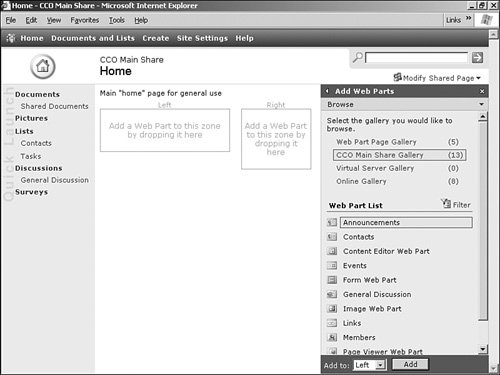Customizing and Developing WSS Sites
| Windows SharePoint Services has many out-of-the-box new features that make it easier to customize using the browser interface. This provides nonprogrammers with a mechanism to create and customize sites to meet their needs. For developers, the following provides an overview of the SharePoint technical structure. Windows SharePoint Services is built on the .NET platform. Use of the .NET platform enables SharePoint to assimilate information from multiple systems into an integrated solution. ASP.NET contains many new features, and it is more responsible, secure, and scalable than ASP. Using ASP.NET reduces the amount of code that needs to be written over similar ASP solutions. SharePoint's SQL back end provides access to internal database components using industry-standard tools. From an application standpoint, integration with BizTalk provides access to over 300 application connectors using Web Services calls. In Windows SharePoint Services, sites and lists can be saved as templates, stored in a Site or List Template library, and then made available to all sites in the collection. There is also a library for Web Parts that can be shared across all sites in the collection. Features such as these provide an environment for developing fully customized WSS solutions. Additional customization and development features are highlighted in the following sections. Using the Browser to Customize SharePointThrough the browser, you can add a logo to the team site, apply a theme, modify a list, or create a new Web Part page. In SharePoint Team Services, there was a template that contained three "zones" for placing Web Parts, producing a three-column view. In Windows SharePoint Services, there are additional zone layouts to choose from, making customization much more user friendly. The new Web Part Tool Pane is a feature that enables users to easily customize sites. It provides the ability to
The site administrator can control what goes into the Web Part libraries and who has access to the libraries for adding Web Parts to a site. Figure 36.14 illustrates the Web Part Tool Pane with its various Web Part libraries and capability to display the contents of the library. Figure 36.14. Displaying the Web Part Tool Pane for access to Web Part libraries. Development Enhancements for Site TemplatesWindows SharePoint Services includes multiple templates that can be used when you create a new site. Each template includes a set of features from Windows SharePoint Services to satisfy a specific collaboration need. Templates are included for
If these don't satisfy the organization's requirements, customized templates can easily be put together using the browser-based customization features, using FrontPage or some other Web design tool, or using programming. For example, if an organization always put its company logo on the home page and used specific Web parts that were unique to their organization, it could save the site as a template and then just duplicate the template when necessary to maintain consistency and security. Improving on FrontPage 2003 IntegrationWith SharePoint Team Services, it was difficult to modify SharePoint sites. FrontPage 2003 is more tightly integrated with Windows SharePoint Services and fully supports Web Parts, Web Part pages, and Web Part zones. This means that Web Parts can be added and customized using FrontPage 2003 to provide the look, feel, and content to meet organizational requirements. Web Parts can be previewed in FrontPage before being published to the SharePoint site, thus providing an "audit" to ensure that the changes have the desired effect. The FrontPage client can be used to back up and restore Windows SharePoint Services sites, providing a much needed feature that was lacking in older versions of the product. Other features provided in FrontPage 2003 include the ability to
|
EAN: 2147483647
Pages: 499